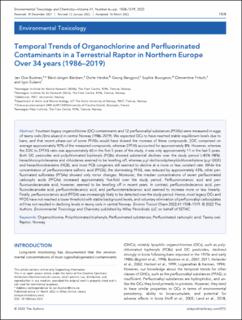| dc.contributor.author | Bustnes, Jan Ove | |
| dc.contributor.author | Bårdsen, Bård-Jørgen | |
| dc.contributor.author | Herzke, Dorte | |
| dc.contributor.author | Bangjord, Georg | |
| dc.contributor.author | Bourgeon, Sophie | |
| dc.contributor.author | Fritsch, Clémentine | |
| dc.contributor.author | Eulaers, Igor | |
| dc.date.accessioned | 2022-07-04T09:12:51Z | |
| dc.date.available | 2022-07-04T09:12:51Z | |
| dc.date.created | 2022-06-13T09:56:21Z | |
| dc.date.issued | 2022 | |
| dc.identifier.citation | Environmental Toxicology and Chemistry. 2022, 41, 1508-1519. | en_US |
| dc.identifier.issn | 0730-7268 | |
| dc.identifier.uri | https://hdl.handle.net/11250/3002542 | |
| dc.description.abstract | Fourteen legacy organochlorine (OC) contaminants and 12 perfluoroalkyl substances (PFASs) were measured in eggs of tawny owls (Strix alueco) in central Norway (1986–2019). We expected OCs to have reached stable equilibrium levels due to bans, and that recent phase-out of some PFASs would have slowed the increase of these compounds. ∑OC comprised on average approximately 92% of the measured compounds, whereas ∑PFAS accounted for approximately 8%. However, whereas the ∑OC to ∑PFAS ratio was approximately 60 in the first 5 years of the study, it was only approximately 11 in the last 5 years. Both OC pesticides and polychlorinated biphenyls (PCBs) showed substantial declines over the study period (~85%–98%): hexachlorocyclohexanes and chlordanes seemed to be levelling off, whereas p,p′-dichlorodiphenyldichloroethylene (p,p′-DDE) and hexachlororbenzene (HCB), and most PCB congeners still seemed to decline at a more or less constant rate. While the concentration of perfluorooctane sulfonic acid (PFOS), the dominating PFAS, was reduced by approximately 43%, other perfluorinated sulfonates (PFSAs) showed only minor changes. Moreover, the median concentrations of seven perfluorinated carboxylic acids (PFCAs) increased approximately five-fold over the study period. Perfluorononanoic acid and perfluoroundecanoate acid, however, seemed to be levelling off in recent years. In contrast, perfluorododecanoic acid, perfluorodecanoate acid, perfluorotridecanoic acid, and perfluorotetradecanoic acid seemed to increase more or less linearily. Finally, perfluorooctanoic acid (PFOA) was increasingly likely to be detected over the study period. Hence, most legacy OCs and PFOS have not reached a lower threshold with stable background levels, and voluntary elimination of perfluoroalkyl carboxylates still has not resulted in declining levels in tawny owls in central Norway. | en_US |
| dc.description.abstract | Temporal Trends of Organochlorine and Perfluorinated Contaminants in a Terrestrial Raptor in Northern Europe Over 34 years (1986–2019) | en_US |
| dc.language.iso | eng | en_US |
| dc.rights | Navngivelse-Ikkekommersiell 4.0 Internasjonal | * |
| dc.rights.uri | http://creativecommons.org/licenses/by-nc/4.0/deed.no | * |
| dc.title | Temporal Trends of Organochlorine and Perfluorinated Contaminants in a Terrestrial Raptor in Northern Europe Over 34 years (1986–2019) | en_US |
| dc.title.alternative | Temporal Trends of Organochlorine and Perfluorinated Contaminants in a Terrestrial Raptor in Northern Europe Over 34 years (1986–2019) | en_US |
| dc.type | Peer reviewed | en_US |
| dc.type | Journal article | en_US |
| dc.description.version | publishedVersion | en_US |
| dc.rights.holder | © 2022 The Authors | en_US |
| dc.source.pagenumber | 1508-1519 | en_US |
| dc.source.volume | 41 | en_US |
| dc.source.journal | Environmental Toxicology and Chemistry | en_US |
| dc.identifier.doi | 10.1002/etc.5331 | |
| dc.identifier.cristin | 2031276 | |
| dc.relation.project | Norges forskningsråd: 268482 | en_US |
| dc.relation.project | NILU: 117068 | |
| cristin.ispublished | true | |
| cristin.fulltext | original | |
| cristin.qualitycode | 2 | |

